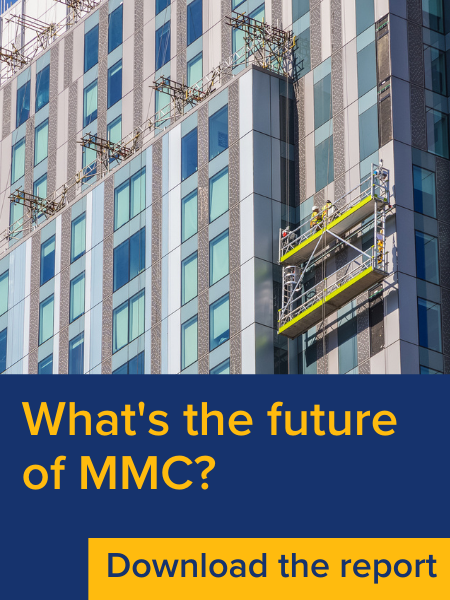
Modern Methods of Construction (MMC) is badged as the sector's opportunity to cultivate a more sustainable future - both financially, with faster capital release and the driving down of costs, and environmentally, supporting the race to carbon-free living. However, significant barriers to creating viable, scalable, and tangible growth projects still remain.
For many, the prospect of the upfront investment in MMC is not sufficiently weighted against the short-term financial benefits needed to drive the progress towards bigger, faster and more profitable projects. However, this conversation is being quickly accelerated after an encouraging move by Barratt Homes earlier this year, which publicised that it will look to MMC to mitigate rising labour costs and skills needs and that 25% of its construction is now carried out using MMC. Whilst we’ve discussed the argument for incentivising MMC to speed up adoption, it's a shift by volume housebuilders that has always been the move needed to pave a realistic path forward for the whole sector.
Industry standards and collaboration
There needs to be a significant advancement in industry standardisation to ensure that MMC products are scalable, profitable and increasingly mortgageable.
At the moment only 8% of homes built in the UK using MMC according to RICS. To ensure MMC grows in scale, and for this to happen quickly, we need to see more standardisation in MMC – in its methods, design and new technologies . It stands to reason that by developing common parts, standard sizing and shared processes, economic and environmental efficiencies will follow.
Standardisation also would offer greater protection for the sector . With so few working at scale with MMC in the residential sector, contractors are at considerable risk if one of their MMC suppliers, for one reason or another, can no longer deliver their contribution to the project. If parts and processes are standardised, it will be much easier for an alternative supplier to step into the project.
Architects and design professionals more generally all have a role to play too - in fully understanding the ever-growing MMC technologies, advising their clients on whether MMC is suitable for their projects, and increasingly collaborating with each other, contractors and the supply chain to make MMC projects a success.
We are already seeing successful collaboration in action through the implementation of the Buildoffsite Property Assurance Scheme (BOPAS). Jointly developed alongside RICS, Lloyd's Register and BLP Insurance, the scheme has given lenders more confidence in the quality, durability, and therefore the mortgageability of MMC homes.
Ownership and risk
The issue of transfer of ownership of goods is another area which requires a modern shake up under the lens of scalability. To facilitate cashflow, it is usual for developers to pay for materials that are offsite and receive a vesting certificate in exchange for giving ownership of those materials, getting access rights to go and see and take photos of the materials and, in a worst-case scenario, the right also to seize the materials should the manufacturer fold before the completion of a project. This works in theory but, without standardisation and with the processes to seize materials being notoriously challenging, the question of ownership needs to be addressed differently if MMC is to work at scale.
Driving scalability and demand
Whilst lessons can be learned from MMC in the construction of commercial retail, hospitals, schools and prisons – all of which contribute to the potential for scalability in the residential sector – emphasis needs to be placed on the fact that consumers generally want more diverse homes. For residential homes, progress needs to support a credible counter-argument for the perceived lack of aesthetics in MMC and to find a way to encourage demand. Rather than incentivising the private sector to build, it is perhaps time to incentivise the consumer to buy. Much like ‘help to buy’, the MMC sector may be crying out for the carrot to motivate consumers to choose a home that could contribute to net zero targets – a ‘buy to help’, if you will.
The funding landscape
Another key element to driving the scalability of MMC is access to funding. Joseph Worland, Associate Director (Housing) at Lloyds Bank confirmed MMC is on the rise across his client base and said: "Most MMC is embedded within existing build methods and is considered normal course of business; these include panelised systems and individual pods for bathrooms and kitchens. The key challenge from a funding perspective is whole-house volumetric systems that utilise completely different supply chains and delivery methods than traditional housing. As the volumetric industry matures, we will see a more standardised approach to lending against MMC assets, and this will be supported by evidence of sustained and stable pipeline generation across the industry.
"We’ve seen a steady increase in uptake of MMC in recent years, whether through volumetric, panelised or other systems, each of which has its own use case and suits certain sectors better than others. In the housing sector we have seen the larger builders introduce MMC to a significant proportion of their homes, supported by ambitions on build quality and sustainability. This is complemented by new players in the market which can be a real force for incrementally increasing the supply of homes in the UK."
Lessons from social housing
The Government is reinforcing the importance of MMC by continuing to invest in policies and schemes to support affordable homes, including the Affordable Homes Programme (2021 to 2026). This grant will help developers to overcome the cost barriers for implementing MMC methods into large scale construction projects.
We’re at the tipping point for a real push for scalable MMC in the housing sector and this is where collaboration becomes key. Although MMC offers a range of benefits, the cost and need for either collaboration or outside funding is proven in the social housing case; incentivisation drives scalability.
To realise the true scale of MMC, processes will need to be formalised and standards agreed. Collaboration will be crucial in steering the conversations surrounding MMC towards the social, economic, and environmental value of MMC rather than just the investment costs.
Value and social value
Jessie Wilde, Deputy Project Director at Bristol Housing Festival feels there is an opportunity as the market engages with MMC to question what we mean by ‘value’ and ‘best value'. Jessie said:
"While MMC is being hailed as having the potential to be cheaper than traditional build, realistically at the moment this isn’t always the case. Particularly with volumetric systems, the significant reduction in price will come with scale. This therefore means that getting ‘best value’ (often a synonym for ‘lowest cost’) excludes a lot of MMC from the playing field. However, it is important that we start to challenge the unspoken and often unquestioned perception of best value.
"In this country we are still building homes today that on completion will need retrofitting in order to meet the sustainability targets in the next few years. MMC provides an opportunity to rethink ‘value’ to start to look at whole life costs, the ‘value’ of social impact, sustainability, ecology, etc. MMC forces this rethink because it is often more expensive when compared to a traditional build when simply comparing the capital cost of the build at completion - however, there are cost benefits to MMC such as reduced time on site, reduced disruption to the local area, and fixed prices that don’t necessarily show up in the ’cost’ comparison, but the ‘value’ of these elements should not be overlooked as the market grows and matures.
"For public bodies the Social Value Act requires the consideration of best value, and this needs to consider more than just capital outlay. Value, beyond monetary value, is difficult to quantify, but there are models being built and used to quantify the added benefits of MMC, the social value, the sustainability value, the reduction in carbon value, the local value, and much more. There is a real opportunity afforded by MMC, as the market is forced to start to rethink the model, to start thinking more holistically at the challenges our cities are facing and the opportunities we are being presented in the market to start to join up some of the solutions."
As MMC continues to drive conversation in the sector and build real momentum on a larger scale, it’s good to explore the challenges and opportunities that exist and how businesses can find the right fit for scalable, sustainable and profitable construction. In our recent blog on supplying skills to the sector, we also explore how the skills shortages and attractiveness play a part in the ability to scale new and different types of construction.




